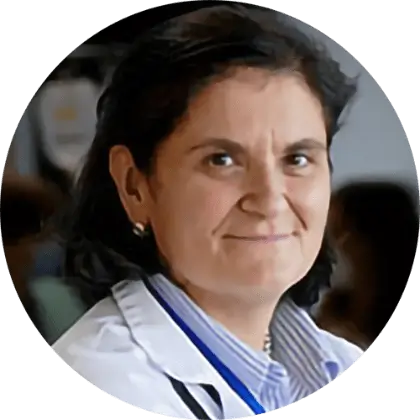Doctor Q&A on CAR-T Cell Therapy: Process, Safety, Emerging Research

Chimeric Antigen Receptor (CAR) T cell therapy is a new and promising approach to treating certain types of cancer, especially blood cancers that have not responded well to other treatments. It involves taking a patient's own immune cells (T cells) and modifying them in a lab to recognize and attack cancer cells. These modified T cells, called CAR-T cells, are then re-infused into the patient, where they can multiply and kill cancer cells.
The following Q&A with Dr. Carmen Martínez Chamorro, Associate Head of Hematology and Hemotherapy at the Quirónsalud Madrid University Hospital, Spain, talks about what CAR-T cell therapy is, how it works, what types of cancer it can treat, the treatment process, recovery, success rates, side effects, limitations, and ongoing research.
Q1. What is CAR-T Cell therapy, and how does it work?
CAR-T cell therapy is an emerging option for treating hematological tumors, especially non-Hodgkin's lymphoma, multiple myeloma, and acute lymphoblastic leukemia, when standard treatments have failed.
This cell therapy is performed with the patient's own lymphocytes that are genetically modified in a laboratory to express receptors that will be directed against an antigen of the tumor cell and thus destroy the tumor cell. Lymphocytes are a type of white blood cell that plays a vital part in the immune system by fighting infections and diseases. There are two main types: B-lymphocytes (B cells) and T-lymphocytes (T cells). B cells produce antibodies, proteins that latch onto specific germs like viruses or bacteria. This flags them for destruction by other immune system cells. On the other hand, T cells directly attack and kill infected cells or cancer cells. They also help regulate the immune response. CAR-T therapy uses T cells.
The first step involves evaluating the patient and the disease to confirm their suitability for therapy, followed by leukapheresis, a procedure by which white blood cells are separated and collected from a sample of blood in order to obtain T-lymphocytes from the patient.
These cells are then shipped to a pharmaceutical laboratory, where they are genetically manipulated to express a receptor that targets the tumor cell. This receptor is known as a chimeric antigen receptor (CAR). After modification, the CAR-T cells are cultured and multiplied in the lab to increase their number. The laboratory freezes the multiplied cells and sends them back to the hospital. This process takes about 3-4 weeks. Some patients, in the meantime, have to receive a bridging therapy to control the growth of the tumor while waiting for the CAR-T cells to be ready.
The genetically modified lymphocytes are cryopreserved in nitrogen tanks and later thawed for administration to the patient after lymphodepletion chemotherapy. The infused CAR-T cells' capacity to proliferate and multiply is enhanced by lymphodepletion chemotherapy, which is administered a few days prior to the CAR-T cell infusion. The CAR-T cells are then infused into the bloodstream in a single infusion, similar to a blood transfusion. Patients usually stay in the hospital for about two weeks following the infusion to closely monitor any possible adverse effects.
Q2. What types of cancer are currently approved for treatment with CAR-T Cell Therapy and who are the candidates for this treatment?
The most common current indications for CAR-T cell therapy include:
- Refractory or relapsed (R/R) aggressive lymphomas such as diffuse large B cell lymphoma (DLBCL), High-grade B-cell lymphoma (HGBCL), and Primary mediastinal large B cell lymphoma (PMBL) after 2 or more courses of systemic treatment, and also, more recently, when they are refractory (unresponsive to treatment) or relapse within 12 months after completing first-line chemoimmunotherapy.
- R/R Follicular lymphoma (FL) after three or more courses of systemic therapy and R/R Mantle cell lymphoma (MCL) after two or more courses of systemic therapy, which includes a Bruton's tyrosine kinase inhibitor (iBTK).
- R/R B-ALL (acute lymphoblastic leukemia) in children and adults.
- R/R Multiple Myeloma following at least three previous treatments - anti-CD38 antibodies, proteasome inhibitors, and immunomodulatory agents - and with disease progression to the last treatment.
To be eligible, patients must have acceptable performance status and adequate organ (renal, hepatic, cardiac, pulmonary) and hematologic (neutrophils, lymphocytes, platelets) function. They cannot have an active infection, other ongoing neoplasms (abnormal, cancerous, or benign growths of tissue), or uncontrolled autoimmune diseases.
Q3. Could you shed more light on these cancer types for the benefit of those who may be unfamiliar with them?
The different types of cancer that could be treated with CAR-T cell therapy can be briefly defined as follows:
B-ALL (Acute Lymphoblastic Leukemia): A fast-growing type of leukemia affecting B-cell precursors in the bone marrow, in children and adults.
Diffuse Large B Cell Lymphoma (DLBCL): A fast-growing, aggressive form of non-Hodgkin lymphoma affecting B-cells. In non-Hodgkin lymphoma, the cancer cells develop in the lymphatic system, which is a part of the body’s immune system. DLBCL originates in the lymphocytes, typically developing in the lymph nodes or other parts of the body, such as the thyroid, brain, gastrointestinal tract, breast, and testes.
Follicular lymphoma (FL): A generally slow-growing type of non-Hodgkin lymphoma that affects B-cells. It can affect the bone marrow, lymph nodes, and other organs.
High-grade B-cell lymphoma (HGBCL): A category of fast-growing lymphomas similar in their aggressive nature to DLBCL. HGBCL is defined by rearrangements (switching of gene segments within chromosomes) in two specific genes.
Mantle cell lymphoma (MCL): A rare and often aggressive subtype of non-Hodgkin lymphoma affecting B-cells in the "mantle zone" of a lymph node. This rare blood cancer begins in white blood cells in the lymph nodes and develops into mantle cell lymphoma, quickly spreading to other areas of the body through the lymphatic system.
Multiple Myeloma: A cancer that impacts the bone marrow and skeletal system, originating from plasma cells, a type of white blood cell responsible for antibody production.
Primary mediastinal large B cell lymphoma (PMBL): A relatively rare type of lymphoma occurring primarily in the area of the chest that separates the lungs (mediastinum).
Q4. What does the recovery process entail?
Recovery may take time as the immune system recovers. The acute recovery period usually lasts 30 days after CAR-T cell infusion. During this time, patients must remain close to the hospital and must have a caregiver with them at all times to monitor signs of fever, infection, and neurological difficulties. Many patients feel tired and have a decreased appetite during this period.
Recovery afterwards is approximately 2-3 months. During this period, side effects and response to treatment will be evaluated. Some patients may require hospitalization to manage complications arising from the treatment.
Q5. What is the success rate of CAR-T Cell Therapy? What are the long-term outcomes and survival rates?
The response rate of CAR-T cell therapy is significantly high and durable. Treatment has shown success even in patients with very poor prognoses who failed to respond to any standard treatments (refractory cases) or relapsed after an initial response to several courses of treatment. CAR-T cell therapy has been shown to improve prognoses over standard treatments.
Responses vary across different cases and the type of CAR-T cell therapy administered. However, the approximate overall response rate ranges from 70-90% and the complete response rate from 50-70%. The median progression-free survival duration is long, and roughly half of the patients are free of disease relapse in the long term.
Q6. How safe is CAR-T Cell Therapy? What are the possible side effects and complications?
According to studies, mortality associated with CAR-T cell therapy is low, ranging from 0 to 6%. Following therapy, the disease's progression or relapse is the primary cause of death.
Even so, the therapy has well-known and potentially serious adverse effects, which experts can promptly diagnose and treat. Side effects are mostly reversible. The most common side effects are as follows:
- Cytokine Release Syndrome (CRS): When modified T cells start attacking cancer cells, they release a large amount of cytokines - proteins that can make the immune system overreact - which sets off the immunological response that leads to CRS. This can cause fever, low blood pressure, muscle pain, flu-like symptoms, cough, and shortness of breath, among others. Serious cases of CRS may result in organ failure or even death. Most symptoms related to CRS can be treated with medications and close monitoring.
- Neurotoxicity: Also known as immune effector cell-associated neurotoxicity syndrome (ICANS), this is another common and unique toxicity following CAR-T cell therapy. Confusion, seizures, and trouble speaking or walking are possible symptoms. With diligent observation, most cases of neurotoxicity have no long-term adverse effects.
- Cytopenia and/or hypogammaglobulinemia: CAR-T cell therapy may cause anemia, thrombopenia (low platelet counts), and/or neutropenia, a condition where the level of neutrophils in the blood is abnormally low, weakening the body's ability to fight infection. It may also cause hypogammaglobulinemia (reduction of immunoglobulins, which are defensive antibodies). Some people may experience more severe side effects, but these are usually transient and go away with time.
- Infections: Patients receiving CAR-T cell therapy may be at increased risk of infection, especially when white blood cell counts and/or immunoglobulins are low. They need to be continuously watched for signs of infection, such as fever, chills, malaise, cough, urinary discomfort, etc.
- Long-term side effects: As CAR-T cell therapy is still relatively new, potential long-term side effects are still being studied.
Q7. What are the major challenges and limitations of CAR-T cell therapy?
A challenging issue is the complexity and cost of CAR-T therapy, which limits the number of patients who can benefit from the treatment.
Another aspect is the time needed to manufacture the CAR-T cells, which is sometimes too long for patients with very aggressive tumors. In this regard, allogeneic (off-the-shelf) CAR-T cells are being tested and could be a rapidly available alternative.
Q8. What happens in cases of treatment failure?
In case of treatment failure, there are other options, such as bispecific monoclonal antibodies. Data from clinical trials have shown that patients who had previously failed to respond to CAR-T cell therapy had a very good response with bispecific monoclonal antibodies.
There are also ongoing trials with other drugs with different mechanisms of action and other forms of cellular immunotherapy (with NK cells, macrophages) against different tumor cell targets. NK cells (natural killer cells) and macrophages are types of immune cells that can be programmed to identify and eliminate cancerous cells. NK cells play a vital part in the body's first line of defense against tumors and virally infected cells, while macrophages are involved in the destruction of foreign substances and are capable of engulfing and digesting cellular debris and pathogens.
Q9. How does CAR-T therapy compare with bispecific antibody treatment?
Both treatments redirect the patient's immune system against the tumor and have pros and cons.
Bispecific monoclonal antibodies, commonly referred to as "Bispecifics," are engineered antibodies designed to simultaneously bind to two different types of antigens. This dual targeting capability enables them to recruit and direct immune cells to tumor cells, enhancing the capacity of the immune system to recognize and destroy cancer cells. Bispecifics are readily available, which is of great importance in patients with rapidly progressive tumors who cannot wait for CAR-T cells to be manufactured. Bispecifics are also easier to administer and have fewer adverse effects, such as CRS and neurotoxicity. This is particularly significant for frail patients.
An advantage of CAR-T cell therapy is that it is given in a single dose, which is very effective and could last a long time without requiring any other therapy. On the other hand, bispecifics are administered on an ongoing basis.
Q10. What are the promising research studies involving CAR-T cell therapy that are currently ongoing? Can it treat conditions other than cancer?
It is likely that in the future CAR-T cell therapy will be approved in earlier lines of treatment for hematological malignancies. Clinical trials have been conducted using it as first-line treatment, but the results are still pending. The combination of CAR-T cells with other immunotherapies, such as checkpoint inhibitors and other drugs, is being investigated. The use of CAR-T cell therapy before or after stem cell transplantation and in earlier disease stages is also being studied.
There are also clinical trials with strategies to reduce adverse effects and utilizing other cell types, such as NK cells, macrophages, and allogeneic T cells.
CAR-T cell therapy can be effective in other non-tumor diseases, with first data on its effectiveness in treating autoimmune diseases already available. Clinical trials are also underway into the treatment of neurological diseases such as multiple sclerosis using CAR-T cell therapy.

Dr. Carmen Martínez Chamorro is the Associate Head of the Hematology and Hemotherapy service at the Quirónsalud Madrid University Hospital, Spain. She is also the CAR-T cell therapy co-ordinator at the same facility.
Dr. Chamorro has a degree in Medicine and Surgery from the University of Valladolid. She completed her Doctor of Medicine and Surgery from the Autonomous University of Madrid and is currently a Professor at the Faculty of Medicine at the European University, Madrid. She has been taking care of the Clinical Hematology and Hematopoietic Transplant Service of the Quirónsalud Madrid University Hospital since 2007.
Her areas of interest include onco-hematological malignancies (leukemia, lymphoma and myeloma), hematopoietic transplantation and CAR-T cell therapy.
Dr. Chamorro has authored 20 published articles in national and international journals, presented more than 60 papers in international and national conferences, and has penned 10 book chapters. She speaks regularly at specialty conferences and congresses.
She has participated as an Investigator in more than 15 clinical trials, 9 of them as Principal Investigator. She is currently a member of the Clinical Trials Committee of the Quirónsalud Madrid University Hospital.

Quirónsalud University Hospital Madrid is a tertiary care center, spanning all medical specialties, with 400 physicians all certified by the Spanish Medical Association. The hospital is equipped to carry out complicated operations, including cardiac surgery, neurosurgery, oncological surgery and brain surgery. Other areas of excellence include Plastic surgery, Oncology and Assisted reproduction.
References:
Featured Blogs



